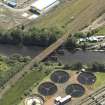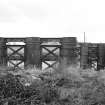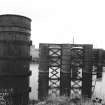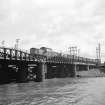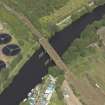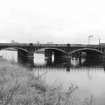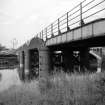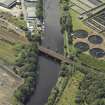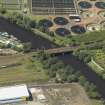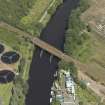Glasgow, Dalmarnock, Western Railway Bridge
Railway Bridge(S) (19th Century)
Site Name Glasgow, Dalmarnock, Western Railway Bridge
Classification Railway Bridge(S) (19th Century)
Alternative Name(s) Dalmarnock, First Railway Bridge; River Clyde
Canmore ID 165929
Site Number NS66SW 365
NGR NS 61344 62500
Datum OSGB36 - NGR
Permalink http://canmore.org.uk/site/165929
- Council Glasgow, City Of
- Parish Glasgow (City Of Glasgow)
- Former Region Strathclyde
- Former District City Of Glasgow
- Former County Lanarkshire
NS66SW 365 61344 62500
Location formerly cited as NS 6134 6249.
For Eastern (second) railway bridge at this crossing-point, see NS66SW 364.
Railway bridges, Dalmarnock, built [NS66SW 365] c. 1858 by G Graham, engineer, and [NS66SW 364] 1893-7 for the Caledonian Rly. Two iron bridges, each carrying two tracks. The western bridge [NS66SW 365] has three bowed lattice girder spans on triple cast-iron piers, and approach spans of normal plate girder type.
J R Hume 1974.
(Railway Bridges, Dalmarnock). Only relics survive of the first [Dalmarnock] bridge, a two-track iron girder bridge built in 1859-61. Engineer George Graham of the Caledonian Railway Co, possibly with Blyth and Cunningham. Some fine chunky castings; large-diameter vertical cylinders, three in line for each support, X-framed bracing panels between them and thick I-beams spanning across their tops. The girders, deck and track have gone.
E Williamson, A Riches and M Higgs 1990.
This bridge formerly carried the Glasgow (Central) - Bridgeton - Rutherglen suburban line of the former Caledonian Rly over the River Clyde, which here forms the boundary between the parishes of Glasgow (to the N) and Rutherglen (to the S). It is situated about 10m W of the later bridge (NS66SW 364), and skew to the river.
The cited location defines the centre of the span. The bridge is depicted (but not noted) on the relevant sheets of the OS 1:1250 map, both of which date from 1968. It appears to have extended from NS c. 61334 62543 to NS c. 61355 62430.
Information from RCAHMS (RJCM), 14 December 2005.
Project (2007)
This project was undertaken to input site information listed in 'Civil engineering heritage: Scotland - Lowlands and Borders' by R Paxton and J Shipway, 2007.
Publication Account (2007)
Dalmarnock Bridge (Railway) is a wrought-iron twin-track bridge on the Caledonian Railway (Dalmarnock branch) erected between 1859 and 1861. It comprised three tied-arch river spans of 70 ft and four 50 ft wrought-iron plate-girder land spans. The main girders were of bowstring construction 7 ft 712 in. deep at
the centre and crossed the river on a skew of 618 30’. Only its piers now remain. The engineer was George
Graham.An early example of pier founding using concrete-filled cast-iron cylinders sunk by open grabbing, in this instance to a depth of 14–22 ft below low-water level. There are three 512 ft diameter cylinders to each pier and five braced together at each abutment.
R Paxton and J Shipway 2007
Reproduced from 'Civil Engineering heritage: Scotland - Lowlands and Borders' with kind permission of Thomas Telford Publishers.
















